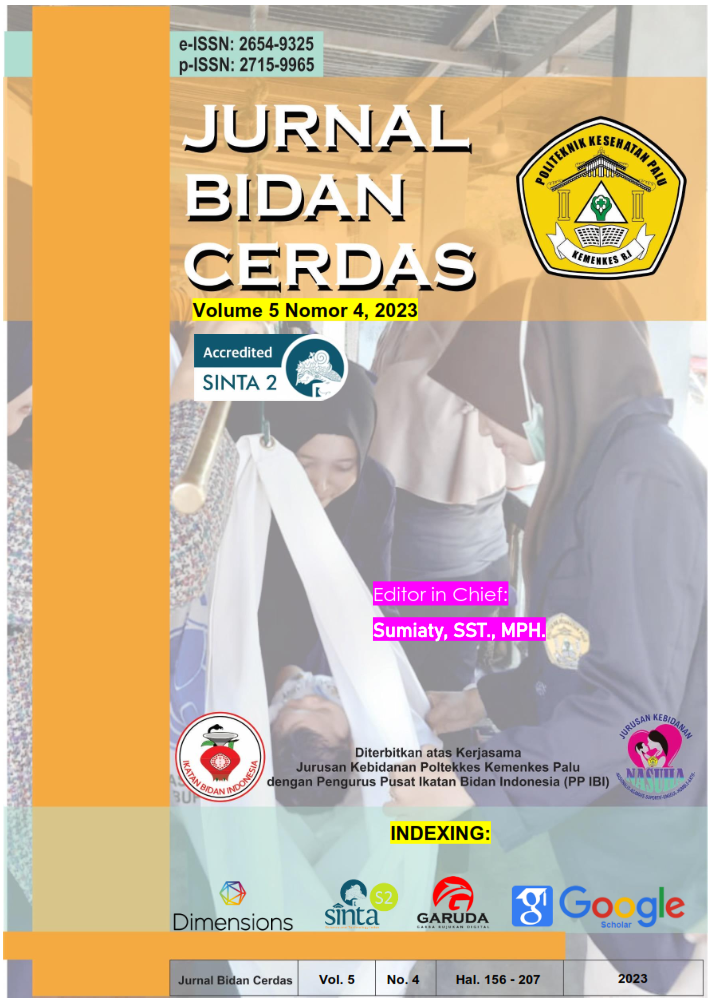Review of Risk Factors in Breast Cancer Incidence: The Main Role of the Age at First Pregnancy
Keywords:
breast cancer, age at first pregnancy, smoking history , age at first menstruationAbstract
Introduction: According to Indonesia's Global Burden Cancer (GLOBOCAN) in 2020, breast cancer accounted for the highest incidence among cancer cases, contributing to 16.6% of the total cases and causing 9.6% of deaths. In 2021, South Jakarta recorded the highest incidence of breast cancer within DKI Jakarta, with 172 cases out of 299. Objective: This study aims to identify the dominant factors influencing the occurrence of breast cancer. Methods: Employing explanatory research, the study involved 112 respondents selected through accidental sampling. Logistic regression analysis was employed for multivariate analysis. Results: The findings revealed three variables with significance levels (Sig.) less than 0.05: age at first menstruation (Sig.=0.005), age at first pregnancy (Sig.<0.001), and smoking history (Sig.=0.018). Exp (B) results indicated that the age of first pregnancy has the greatest impact, with a likelihood 8.6 times higher. Conclusion: Consequently, the study concludes that the age of the woman during the first pregnancy emerges as the most dominant factor influencing breast cancer, pointing to the critical period of estrogen exposure. This study underscores the importance of understanding and addressing these factors in breast cancer prevention and intervention strategies, providing valuable insights for public health initiatives.
Downloads
References
Agustina, N. (2022). Fakta Bahwa Rokok Penyebab Kanker. Retrieved from Kementrian Kesehatan website: https://yankes.kemkes.go.id/view_artikel/14/fakta-bahwa-rokok-penyebab-kanker
Ahmed, S. D. H., Idrees, F., Ahsan, M., Khanam, A., Sultan, N., & Akhter, N. (2018). Association of serum leptin with serum estradiol in relation to breast carcinogenesis: A comparative case-control study between pre- and postmenopausal women. Turkish Journal of Medical Sciences, 48(2), 305–310. https://doi.org/10.3906/sag-1704-10
CDC. (2023). What Is Breast Cancer? Retrieved from https://www.cdc.gov/cancer/breast/basic_info/what-is-breast-cancer.htm
Clèries, R., Rooney, R. M., Vilardell, M., Espinàs, J. A., Dyba, T., & Borras, J. M. (2018). Assessing predicted age-specific breast cancer mortality rates in 27 European countries by 2020. Clinical and Translational Oncology, Vol. 20, pp. 313–321. https://doi.org/10.1007/s12094-017-1718-y
Dati, T. Y., Sasputra, I. N., Rante, S. D. T., & Artawan, I. M. (2021). Faktor Risiko Kanker Payudara Di RSUD Prof . Dr . W . Z.Johannes Kupang Nusa Tenggara Timur Tahun 2017-2019. Cendana Medical Journal, 22(November), 265–271. Retrieved from https://ejurnal.undana.ac.id/index.php/CMJ/article/view/5979/3311
DeSantis, C. E., Ma, J., Goding Sauer, A., Newman, L. A., & Jemal, A. (2017). Breast cancer statistics, 2017, racial disparity in mortality by state. CA: A Cancer Journal for Clinicians, 67(6), 439–448. https://doi.org/10.3322/caac.21412
Dewi, G. A. T., & Hendrati, L. Y. (2016). Breast Cancer Risk Analysis by the Use of Hormonal Contraceptives and Age of Menarche. Jurnal Berkala Epidemiologi, 3(1), 12. https://doi.org/10.20473/jbe.v3i12015.12-23
Dinkes DKI. (2022). Profil Kesehatan Dki Jakarta 2021 Dan Lampiran. DKI JAKARTA. Retrieved from https://drive.google.com/file/d/1ouF8eYDreYu_8Tz2WIhbajJaYklw5NTm/view
Fard, Z. T., Rouhollah, F., & and Nahid Nafisi. (2018). Serum Liver Proteins and 17?-estradiol in.pdf. Research in Molecular Medicine (RMM), 6(4), 40–58. https://doi.org/10.18502/rmm.v6i4.4803
Gaudet, M. M., Gapstur, S. M., Sun, J., Ryan Diver, W., Hannan, L. M., & Thun, M. J. (2013). Active smoking and breast cancer risk: Original cohort data and meta-analysis. Journal of the National Cancer Institute, 105(8), 515–525. https://doi.org/10.1093/jnci/djt023
Herawati, A., Rijal, S., St Fahira Arsal, A., Purnamasari, R., Amelia Abdi, D., & Wahid, S. (2022). Karakteristik Kanker Payudara. Fakumi Medical Journal: Jurnal Mahasiswa Kedokteran, 2(5), 359–367. Retrieved from https://fmj.fk.umi.ac.id/index.php/fmj/article/view/76/72
Kemenkes RI. (2018). Melahirkan _ Meningkatkan, Lalu Menurunkan Risiko Kanker Payudara - Direktorat P2PTM. Retrieved from Kemenkes RI Direktorat Jenderal P2P website: https://p2ptm.kemkes.go.id/tag/melahirkan-meningkatkan-lalu-menurunkan-risiko-kanker-payudara
Kementrian Kesehatan Republik Indonesia. (2019). Penyakit Kanker di Indonesia Berada Pada Urutan 8 di Asia Tenggara dan Urutan 23 di Asia – P2P Kemenkes RI. Retrieved from P2P.kemkes.go.id website: http://p2p.kemkes.go.id/penyakit-kanker-di-indonesia-berada-pada-urutan-8-di-asia-tenggara-dan-urutan-23-di-asia/
Maria, I. L., Sainal, A. A., & Nyorong, M. (2017). Lifestyle Risk Factors of Women with Breast Cancer. Media Kesehatan Masyarakat Indonesia, 13(2), 157–166. Retrieved from https://journal.unhas.ac.id/index.php/mkmi/article/view/1988
Meier-Abt, F., & Bentires-Alj, M. (2014). How pregnancy at early age protects against breast cancer. Trends in Molecular Medicine, Vol. 20, pp. 143–153. https://doi.org/10.1016/j.molmed.2013.11.002
Mørch, L. S., Skovlund, C. W., Hannaford, P. C., Iversen, L., Fielding, S., & Lidegaard, Ø. (2017). Contemporary Hormonal Contraception and the Risk of Breast Cancer. New England Journal of Medicine, 377(23), 2228–2239. https://doi.org/10.1056/nejmoa1700732
Sari, N., & Pasalina, P. E. (2023). Usia Hamil Pertama Sebagai Prediktor Kadar Estradiol Wanita Usia Subur Penderita Kanker Payudara. JIK (Jurnal Ilmu Kesehatan), 7(1), 164–168. Retrieved from https://jik.stikesalifah.ac.id/index.php/jurnalkes/article/view/643
WHO. (2020a). Breast cancer – IARC. Retrieved from Https://Www.Iarc.Who.Int/Cancer-Type/Breast-Cancer/ website: https://www.iarc.who.int/cancer-type/breast-cancer/
WHO. (2020b). International Agency for Research on Cancer. Retrieved from WHO Source Globocan website: https://gco.iarc.fr/today/data/factsheets/populations/900-world-fact-sheets.pdf
WHO Indonesia. (2020). Cancer in Indonesia. In Indonesia Source: Globocan 2020 (Vol. 247). Retreived from https://gco.iarc.fr/today/data/factsheets/populations/360-indonesia-fact-sheets.pdf
Published
How to Cite
Issue
Section
Copyright (c) 2023 Fenti Hasnani, Ani Nuraeni, Nora Hayani, Nuswatul Khaira

This work is licensed under a Creative Commons Attribution-ShareAlike 4.0 International License.
Authors who publish with Jurnal Bidan Cerdas agree to the following terms:
- Authors retain copyright and grant the journal right of first publication with the work simultaneously licensed under a Creative Commons Attribution License (CC BY-SA 4.0) that allows others to share the work with an acknowledgment of the work's authorship and initial publication in this journal.
- Authors are able to enter into separate, additional contractual arrangements for the non-exclusive distribution of the journal's published version of the work (e.g., post it to an institutional repository or publish it in a book), with an acknowledgment of its initial publication in this journal.
- Authors are permitted and encouraged to post their work online (e.g., in institutional repositories or on their website) prior to and during the submission process, as it can lead to productive exchanges, as well as earlier and greater citation of published work.

This work is licensed under a Creative Commons Attribution-Share Alike 4.0 International License
You are free to:
- Share, copy and redistribute the material in any medium or format
- Adapt, remix, transform, and build upon the material for any purpose, even commercially.
- The licensor cannot revoke these freedoms as long as you follow the license terms.





